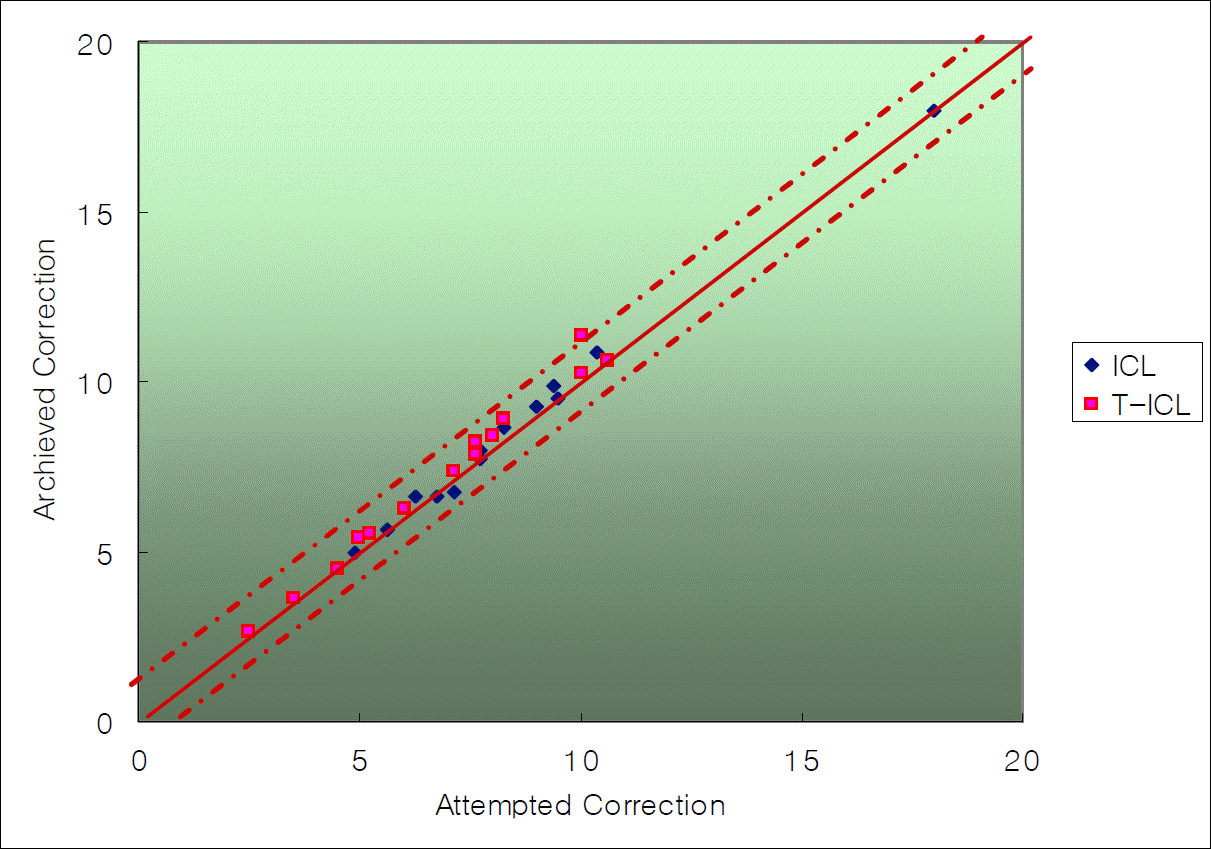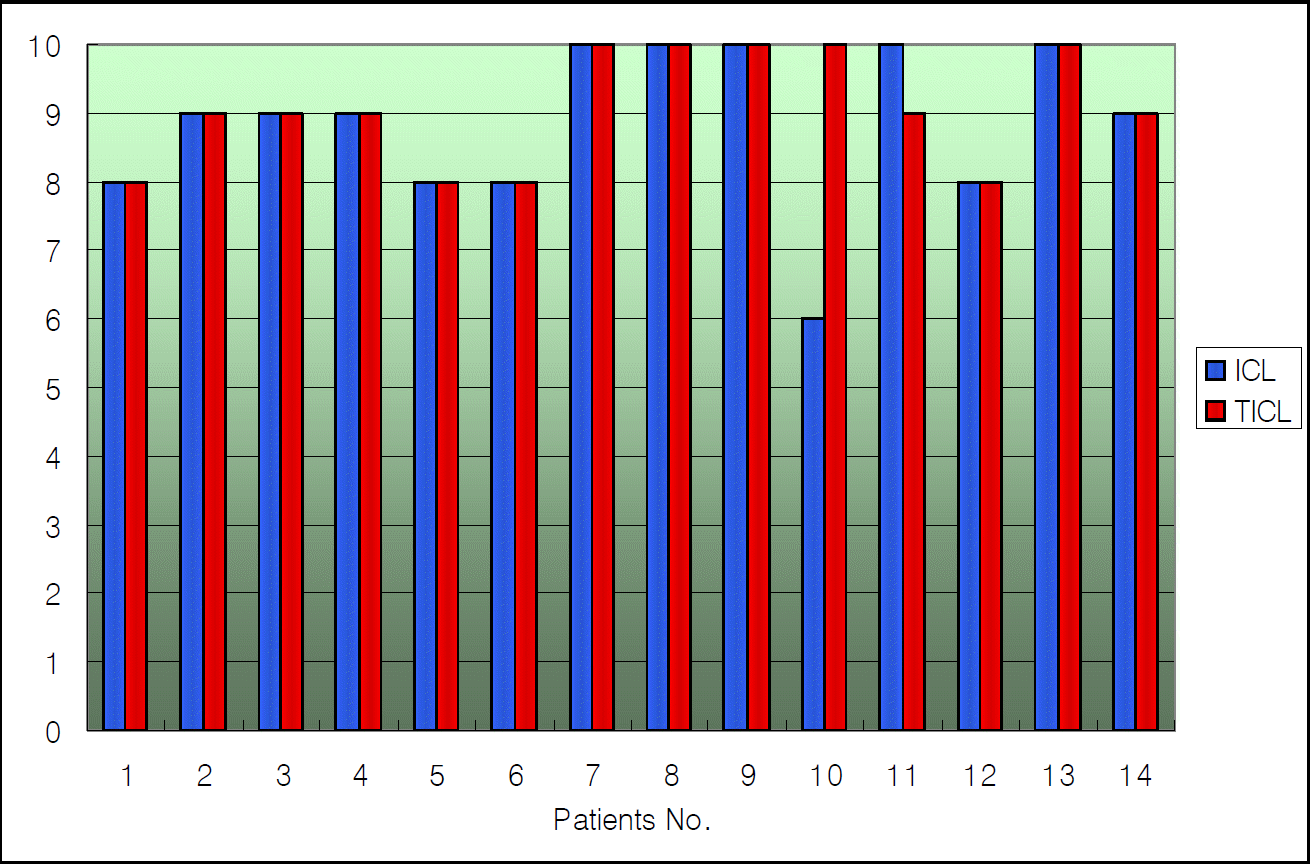Abstract
Purpose
We compared intra-individual visual outcomes and patient satisfaction after implantable contact lens (ICL) and Toric ICL implantation.
Methods
Twenty-eight eyes of 14 patients were enrolled in this retrospective study. One eye of each patient was assigned to ICL (ICL Group), and the contralateral eye was allocated to Toric ICL (Toric ICL Group). All patients were examined for visual acuity, refraction, intraocular pressure, slit lamp measurements, and satisfaction one week, one month, two months, and six months postoperatively.
Results
Mean spherical equivalents of the two groups were corrected from -7.83D (ICL Group) and -5.55D (Toric ICL Group) to 0.13D and 0.20D, respectively, and the mean refractive cylinders were corrected from 0.92D and 2.60D to 0.42D and 0.27D, respectively, at six months postoperatively. The myopias of these two groups and the astigmatism of the Toric ICL group were effectively corrected. The uncorrected visual acuity (UCVA) of the two groups were 1.02 and 1.05, respectively, at six months postoperatively. The safety index, efficacy index, predictability, and stability were favorable. There were no significant differences between the two groups in terms of postoperative UCVA, intraocular pressure(IOP), vaulting, noticeable complications, or patient satisfaction.
References
2. Maloney RK, Nguyen LH, John ME. Artisan phakic intraocular lens for myopia:short-term results of a prospective, multicenter study. Ophthalmology. 2002; 109:1631–41.
3. Stulting RD, John ME, Maloney RK, et al. Three-year results of Artisan/Verisyse phakic intraocular lens implantation. Results of the United States Food And Drug Administration clinical trial. Ophthalmology. 2008; 115:464–72.
4. Bartels MC, Saxena R, van den Berg TJ, et al. The influence of incision-induced astigmatism and axial lens position on the correction of myopic astigmatism with the Artisan toric phakic intraocular lens. Ophthalmology. 2006; 113:1110–7.

5. Coullet J, Guell JL, Fournie P, et al. Iris-supported phakic lenses (rigid vs foldable version) for treating moderately high myopia: randomized paired eye comparison. Am J Ophthalmol. 2006; 142:909–16.

6. Chun YS, Lee JH, Lee JM, et al. Outcomes after implantable contact lens for moderate to high myopia. J Korean Ophthalmol Soc. 2004; 45:480–9.
7. Han SY, Lee KH. Long term effect of ICL implantation to treat high myopia. J Korean Ophthalmol Soc. 2007; 48:465–72.
8. Sanders DR, Brown DC, Martin RG, et al. Implantable contact lens for moderate to high myopia: phase I FDA clinical study with 6 month followup. J Cataract Refract Surg. 1998; 24:607–11.
9. Sanders DR, Vukich JA, Doney K, Gaston M. U.S. Food and Drug administration clinical trial of the implantable contact lens for moderate to high myopia. Ophthalmology. 2003; 110:255–66.

10. Sanders DR, Schneider D, Martin R, et al. Toric Implantable Collamer Lens for moderate to high myopic astigmatism. Ophthalmology. 2007; 114:54–61.

11. Uusitalo RJ, Aine E, Sen NH, Laatikainen L. Implantable contact lens for high myopia. J Cataract Refract Surg. 2002; 28:29–36.

12. Assetto V, Benedetti S, Pesando P. Collamer intraocular contact lens to correct high myopia. J Cataract Refract Surg. 1996; 22:551–6.

13. Arne JL, Lesueur LC. Phakic posterior chamber lenses for high myopia: functional and anatomical outcomes. J Cataract Refract Surg. 2000; 26:369–74.

14. Yoon JM, Moon SJ, Lee KH. Clinical Outcomes of Toric Implantable Collamer Lens implantation. J Korean Ophthalmol Soc. 2009; 50:839–51.

15. Chang J, Lau S. Toric Implantable Collamer Lens for high myopic astigmatic Asian eyes. Ophthalmology. 2009; 116:2340–7.

16. Jimenez-Alfaro I, Benitez del Castillo JM, Garcia-Feijoo J, et al. Safety of posterior chamber phakic intraocular lenses for the correction of high myopia. Anterior segment changes after posterior chamber phakic intraocular lens implantation. Ophthalmology. 2001; 108:90–9.
17. Mendicute J, Irigoyen C, Ruiz M, et al. Toric intraocular lens versus op-posite clear corneal incisions to correct astigmatism in eyes having cataract surgery. J Cataract Refract Surg. 2009; 35:451–8.

18. Kamiya K, Shimizu K, Igarashi A, Komatsu M. Comparison of Collamer toric implantable contact lens implantation and wave-front-guided laser in situ keratomileusis for high myopic astigmatism. J Cataract Refract Surg. 2008; 34:1687–93.
19. Sanders DR, Vukich JA. Comparison of implantable contact lens and laser assisted in situ keratomileusis for moderate to high myopia. Cornea. 2003; 22:324–31.

20. Sanders D, Vukich JA. Comparison of implantable collamer lens (ICL) and laser-assisted in situ keratomileusis (LASIK) for low myopia. Cornea. 2006; 25:1139–46.

21. Sanders DR, Vukich JA. Incidence of lens opacities and clinically significant cataracts with the implantable contact lens: comparison of two lens designs. J Refract Surg. 2002; 18:673–82.

22. Gonvers M, Bornet C, Othenin-Girard P. Implantable contact lens for moderate to high myopia: relationship of vaulting to cataract formation. J Cataract Refract Surg. 2003; 29:918–24.
23. Lackner B, Pieh S, Schmidinger G, et al. Long-term results of implantation of phakic posterior chamber intraocular lenses. J Cataract Refract Surg. 2004; 30:2269–76.

24. Sarikkola A-U, Sen HN, Uusitalo RJ, Laatikainen L. Traumatic cataract and other adverse events with the implantable contact lens. J Cataract Refract Surg. 2005; 31:511–24.

Figure 1.
Attempted vs achieved spherical equivalent at 6 months after ICL and Toric ICL implantation.

Table 1.
Patient demographics
Table 2.
Comparison of spherical equivalent (SE) over time between the ICL and Toric ICL groups (Diopter)
Table 3.
Comparison of refractive cylinder (RC) over time between the ICL and Toric ICL groups (Diopter)
Table 4.
Preoperative best spectacle-corrected visual acuity (BSCVA), postoperative uncorrected visual acuity (UCVA), safety index and efficacy index at 6 month postoperatively




 PDF
PDF ePub
ePub Citation
Citation Print
Print



 XML Download
XML Download